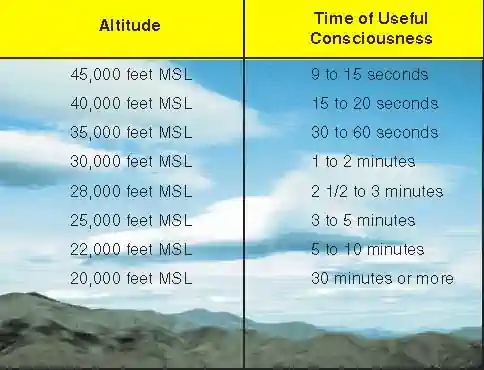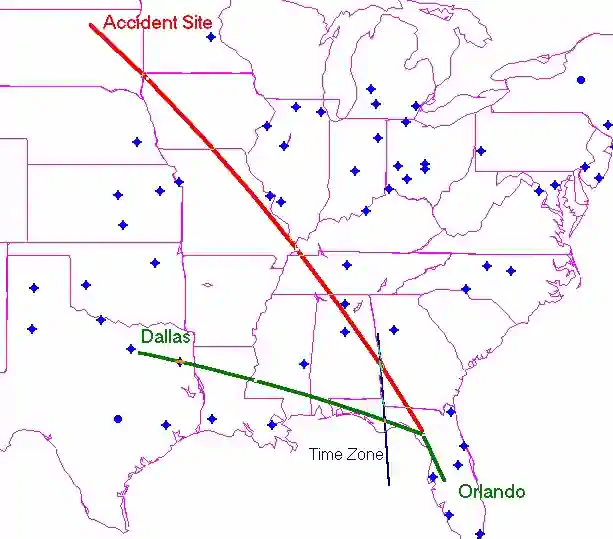Hypoxia
Hypoxia is the condition in which there is an insufficient amount of oxygen in the blood, tissues, and/or cells to maintain normal physiological function, which is particularly hazardous in the aviation environment.
Introduction to Hypoxia
- Hypoxia occurs when the tissues of the body do not receive enough oxygen, leading to incapacitating effects.
- Depending on the cause, pilots experience various types of hypoxia.
- While hypoxia is most often associated with higher altitudes, several other causes causes exist.
- Symptoms can be difficult to detect, especially when flying as a single-pilot, but left untreated, they can quickly turn deadly.
- While easily treated, several factors can put a pilot at greater risk, necessitating hypoxia prevention and proper training as a first-line defense against hypoxia.
- Furthermore, oxygen requirements will help mitigate risk and serve as a preventive measure.
- Several case studies have shown that hypoxia can be deadly.
Hypoxia Overview
- Hypoxia occurs when body tissues do not receive enough oxygen, leading to incapacitating effects. [Figure 1]
- The result of hypoxia is impairment, but the degree of impairment will vary depending on the exposure time and the severity of the conditions that led to that exposure.
- Awareness of hypoxia allows for proper mitigation controls to reduce its likelihood or minimize the result that could otherwise occur.
Potential Causes of Hypoxia
- Since hypoxia is the lack of sufficient oxygen in the body, hypoxia can result from several factors or a combination of those factors.
- Equipment failure, such as leaky oxygen systems, inoperative oxygen masks, regulators, or depressurization, can lead to conditions that result in hypoxia.
- Improper use of equipment, such as an improperly fitted mask or incorrect procedures, may result in hypoxia.
- Factors such as underlying health issues, behaviors, or environmental factors can make the body increasingly susceptible to hypoxia.
- Hypoxia may also result from certain flight conditions that restrict blood flow throughout the body.
- Of course, simply spending too much time in a high-altitude environment can result in hypoxia.
- Hypoxia is a broad term that encompasses various types, which can be classified based on the factors that contribute to them.
Types of Hypoxia
- There are four types of hypoxia, based on the source:
-
Hypoxic Hypoxia:
- Also referred to as altitude hypoxia, hypoxic hypoxia is a condition in which the body fails to absorb sufficient oxygen due to lower atmospheric pressure.
- As pressure altitude increases, the partial pressure of oxygen decreases, along with a corresponding decrease in blood oxygen saturation.
- The significant decrease in pressure leads to the body's inability to absorb oxygen.
- The oxygen concentration in the atmosphere remains consistent at all altitudes (about 21%), whereas pressure is reduced by 50% by 18,000' and 75% by 34,000'.
- Hypoxic hypoxia can occur due to faulty equipment, malfunctions, or improper use.
-
Hypemic Hypoxia:
- Hypemic hypoxia occurs when the blood is unable to carry a sufficient amount of oxygen to the body's cells.
- Caused by anemia, disease, blood loss, deformed blood cells, or carbon monoxide (CO) poisoning, especially in smokers.
- CO attaches itself to hemoglobin about 200 times more easily than oxygen.
- After CO poisoning, it can take up to 24 hours to recover.
- Donating blood results in a higher physiological altitude.
-
Stagnant Hypoxia:
- Stagnant hypoxia occurs when oxygen deficiency in the body results from poor blood circulation.
- Excessive Gs or exposure to cold temperatures (which constrict blood vessels) can reduce blood flow to the extremities.
- Stagnant hypoxia may cause hyperventilation.
-
Histotoxic Hypoxia:
- Histotoxic hypoxia is the inability of the body to use oxygen.
- Caused by alcohol and other drugs, such as narcotics and poisons.
- Regardless of type, the symptoms of hypoxia remain consistent, requiring pilots to know what to look for to recognize the onset of hypoxia.
Recognizing Hypoxia
-
Hypoxia Symptoms:
- Because of wide individual variations in susceptibility to hypoxia, it is impossible to predict precisely when, where, or how hypoxia reactions will occur in each pilot.
- As a general rule, however, flights below 10,000 feet MSL without the use of supplemental oxygen can be considered safe, though night vision is particularly critical, and impairment of sight can occur at lower altitudes - especially for heavy smokers.
- The onset of hypoxia is insidious and progresses slowly, with symptoms including:
- Euphoria.
- Headache.
- Increased response time.
- Impaired judgment.
- Drowsiness.
- Dizziness.
- Tingling in fingers and toes.
- Numbness.
- Blue fingernails and lips (cyanosis).
- Limp muscles.
- Confusion or foggy decision-making.
-
Debilitating Effects from Hypoxia:
- The effects of hypoxia are usually quite challenging to recognize, especially when they occur gradually.
- This onset (gradual or rapid) and altitude will have a direct effect on the Time of Useful Consciousness (TUC) and Effective Performance Time (EPT).
- Time of Useful Consciousness: refers to the pilot's ability to remain conscious when exposed to high-pressure altitudes. [Figure 2]
- Published times reference a rapid decompression event.
- Effective Performance Time: refers to a pilot's ability to function, regardless of consciousness.
- Time of Useful Consciousness: refers to the pilot's ability to remain conscious when exposed to high-pressure altitudes. [Figure 2]
- The effects appear following increasingly shorter periods of exposure to higher altitudes. [Figure 3]
- Pilot performance can seriously deteriorate within 15 minutes at 15,000 feet.
- Although deterioration in night vision occurs at a cabin pressure altitude as low as 5,000', other significant effects of altitude hypoxia usually do not happen in the typical healthy pilot below 12,000'.
- At altitudes ranging from 12,000 to 15,000 feet, judgment, memory, alertness, coordination, and the ability to make calculations are impaired. Symptoms may include headache, drowsiness, dizziness, and either a sense of well-being (euphoria) or belligerence.
- At cabin pressure altitudes above 15,000', the periphery of the visual field grays out to a point where only central vision remains (tunnel vision).
- Once identified, pilots and passengers must take immediate action to address the conditions that resulted in hypoxia, as well as the debilitating effects that ensued from its onset.
Immediate Action and Treatment of Hypoxia
- If pilots or passengers suspect hypoxic conditions are present:
- Inform your instructor/crew.
- Descend to 10,000' or below.
- Consider executing an emergency descent.
- Select the emergency position with the diluter lever (gang load).
- Slow breathing rate by counting to four or five between breaths.
- Check connections/equipment.
- As always, avoiding the need to take immediate action to treat hypoxia starts with prevention.
Hypoxia Prevention
- For optimum protection, pilots are encouraged to use supplemental oxygen above 10,000' during the day and above 5,000' at night.
- Pilots lose the ability to take corrective and protective action in 20 to 30 minutes at 18,000 feet and 5 to 12 minutes at 20,000 feet, followed soon after that by unconsciousness.
- Pilots can best prevent hypoxia by heeding factors that reduce tolerance to increases in altitude (decreases in pressure), such as enriching the inspired air with oxygen from an appropriate oxygen system and by maintaining a comfortable, safe cabin pressure altitude.
- Medical devices, such as pulse oximeters [Amazon] or smartwatches [Amazon], can indirectly monitor oxygen saturation. [Figure 4/5]
- Several factors can lower the altitude at which significant effects of hypoxia occur.
- Carbon monoxide inhaled in smoking or from exhaust fumes, lowered hemoglobin (anemia), and certain medications can reduce the oxygen-carrying capacity of the blood to the degree that the amount of oxygen provided to body tissues will already be equivalent to the oxygen supplied to the tissues when exposed to a cabin pressure altitude of several thousand feet.
- Rate of pressure change.
- Oxygen is released through rapid decompression, resulting in a loss of TUC by up to 50%.
- Small amounts of alcohol and low doses of certain drugs, such as antihistamines, tranquilizers, sedatives, and analgesics, can, through their depressant action, render the brain much more susceptible to hypoxia.
- Extreme heat and cold, fever, and anxiety increase the body's demand for oxygen, thereby increasing its susceptibility to hypoxia.
- Duration of exposure.
- Individual tolerances.
- Physical activity.
- If the pilot is physically fit and there are no fumes in the cockpit, the situation will probably never occur below 10,000'.
- Self-imposed stress.
- Avoid:
- Smoking or exposure to exhaust fumes.
- Medications.
- Alcohol.
- Oxygen Requirements:
- Federal Aviation Regulations 91.211 requires that, at a minimum, the flight crew be provided with and use supplemental oxygen after 30 minutes of exposure to cabin pressure altitudes between 12,500 and 14,000 feet and immediately on exposure to cabin pressure altitudes above 14,000 feet.
- The crew must provide every occupant of the aircraft with supplemental oxygen at cabin pressure altitudes above 15,000 feet.
- Resources are available for pilots to learn about the physiological effects and how hypoxia specifically impacts them.
Hypoxia Training
- Since symptoms of hypoxia vary in an individual, experiencing and witnessing the effects of hypoxia during an altitude chamber "flight" significantly improves an individual's ability to recognize hypoxia. [Video 1]
- The Federal Aviation Administration (FAA) provides this opportunity through aviation physiology training conducted at the FAA Civil Aeromedical Institute and many military facilities across the U.S. [Figure 6]
- To attend the Physiological Training Program, contact the Civil Aeromedical Institute, Mike Monroney Aeronautical Center, Oklahoma City, OK.
- Aerospace Medical Education Division, AAM-400, CAMI.
- Mike Monroney Aeronautical Center, P.O. Box 25082.
- Oklahoma City, OK 73125.
- Telephone: (405) 954-6212.
- Attendance in the Physiological Training Program requires submission of an application form and payment of a fee.
- Particulars about location, fees, scheduling procedures, course content, individual requirements, etc., are contained in the Physiological Training Application, Form Number AC 3150-7, obtained by contacting the accident prevention specialist or the office forms manager in the nearest FAA office.
Hypoxia Case Studies
- The National Transportation Safety Board Identification: CEN12FA571:
- The NTSB determines the probable cause(s) of this accident to be: The student pilot's impairment from alcohol, marijuana, and hypoxia, which adversely affected his ability to maintain control of the airplane.
- The National Transportation Safety Board Identification: WPR12FA154:
- The NTSB determines the probable cause(s) of this accident to be: The in-flight loss of control due to the pilot's impairment as a result of hypoxia. Contributing to the accident was the pilot's operation of the airplane above 12,500 feet without the aid of supplemental oxygen.
- The National Transportation Safety Board Identification: CEN09LA527:
- The NTSB determines the probable cause(s) of this accident to be: The in-flight loss of control due to the pilot's impairment as a result of hypoxia. Contributing to the accident was the pilot's decision to operate the unpressurized airplane at an altitude requiring supplemental oxygen, despite not having any oxygen available for use.
- The National Transportation Safety Board Identification: ERA09FA429:
- The NTSB determines the probable cause(s) of this accident to be: The pilot's improper modification of the certified, on-board oxygen system, which resulted in incapacitation due to hypoxia, and the airplane's subsequent uncontrolled descent into terrain.
- The National Transportation Safety Board Identification: DCA00MA005:
- The NTSB determines the probable cause(s) of this accident as follows: Incapacitation of the flight crewmembers as a result of their failure to receive supplemental oxygen following a loss of cabin pressurization for undetermined reasons. [Figure 7]
Hypoxia Conclusion
- Note that human performance is affected by pressure altitude.
- Remember, there is no less oxygen at altitude than at sea level; instead, the pressure of that air and the body's ability to absorb it change.
- Compliance, therefore, does not necessarily equate to safety.
- The body's respiratory drive responds primarily to carbon dioxide and only weakly to oxygen levels, which makes the onset of hypoxia insidious.
- Note the connection between supplemental oxygen requirements and hypoxia in case studies.
- These rules are in place because others have died from it.
- Recognize judgment will be impaired when hypoxic.
- Although the regulations spell out specific oxygen requirements, a simple way to remember and a conservative practice is to use oxygen above 5,000' at night and 10,000' during the day.
- A high-altitude endorsement is required if acting as pilot in command of a pressurized airplane with a service ceiling or maximum operating altitude above 25,000 feet.
- Training may be made available through the FAA/Military to help pilots understand their body's response to hypoxia.
- Rapid decompression is immediately recognizable and, therefore, easier to respond to, whereas a gradual decompression is harder to detect, increasing the risk of hypoxia with no clear warnings.
- If you or your passengers experience signs or symptoms of hypoxia, report it so inspectors can examine the aircraft and initiate any necessary engineering inspections.
- Still looking for something? Continue searching:
Hypoxia References
- Advisory Circular 61-21A (Chapter 1) Hypoxia.
- Advisory Circular (61-107) Operations of Aircraft at Altitudes Above 25,000 Feet and/or Mach Numbers (MMO) Greater Than .75.
- Aeronautical Information Manual (8-1-2) Effects of Altitude.
- Aircraft Owners and Pilots Association - Form and Function.
- Aviation Medicine Blog.
- Federal Aviation Administration - Aerospace Physiology Training.
- Federal Aviation Administration - Beware of Hypoxia.
- Federal Aviation Administration - Pilot/Controller Glossary.
- Federal Aviation Regulations (91.211) Supplemental Oxygen.
- Flying Magazine - Technicalities: Hypoxia at Your Fingertips.
- National Transportation Safety Board (NTSB).






